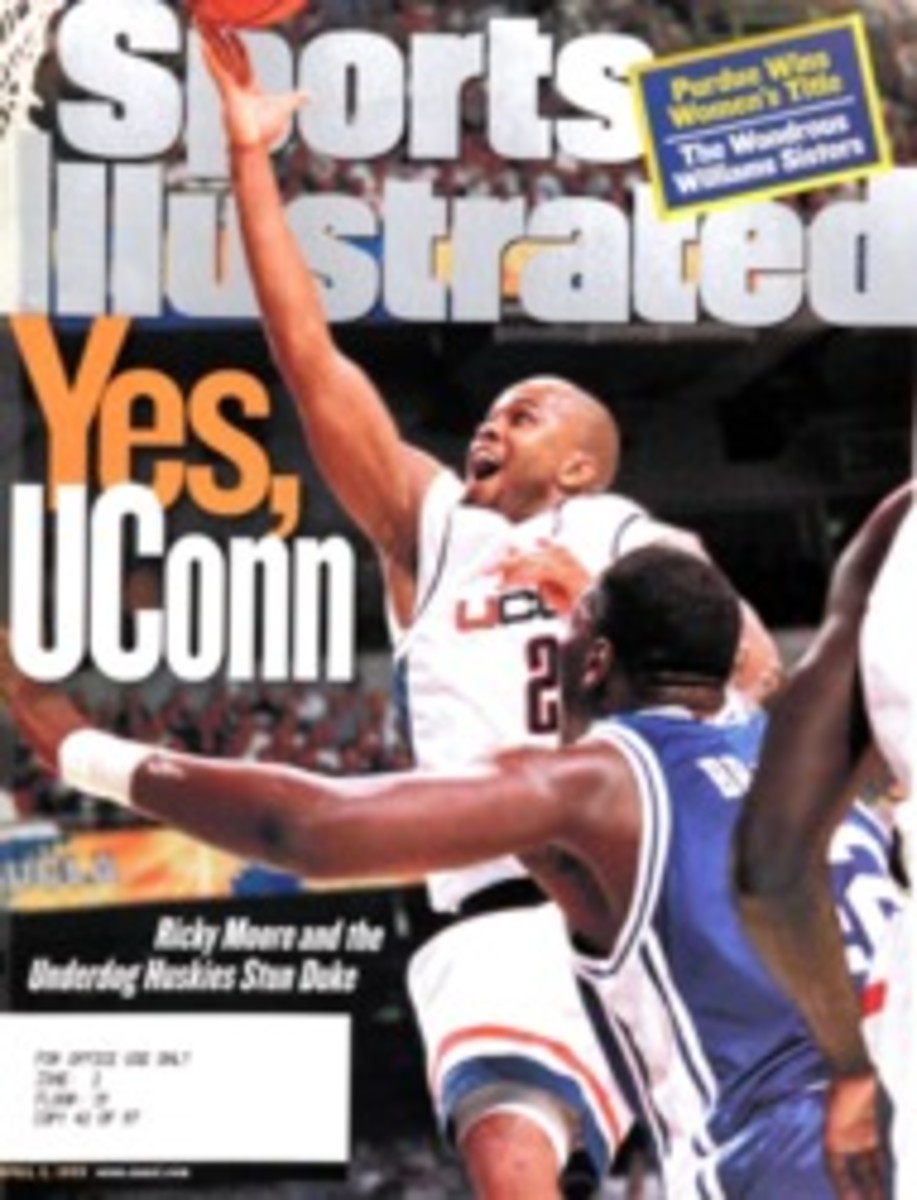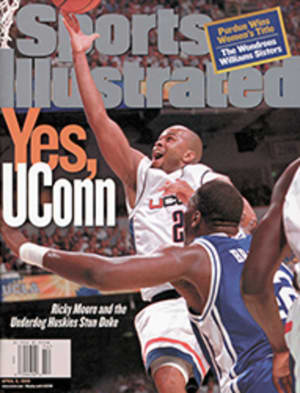
Bombs Away! Augusta's attempt to slow down the long hitters actually gives them a bigger edge
The Masters is known for slam-bam finishes like the one staged
last year by Mark O'Meara, who birdied three of the final four
holes to steal the championship from Fred Couples and David
Duval. But in the 12 months since then, Augusta National has
undergone its most substantial alterations in almost 50 years, a
face-lift that could turn next week's end game into more of a
stare down than a shoot-out.
In 1998 O'Meara birdied the 15th, 17th and 18th holes. This year
those three holes, and others, will no longer play like their
old selves. To illustrate, imagine a hypothetical leader coming
to the 15th tee on Sunday with a one-stroke edge. Looking for an
easy birdie on the 500-yard par-5, he loads up and bombs his
drive wide right, which had been safe territory. But now,
instead of having a clear second shot to the green, he's blocked
by the clusters of 35-foot-high pines that were planted at the
edge of the fairway last summer, and must lay up short of the
water hazard fronting the green. A birdie is no longer a sure
thing. Then on the 17th, what had been an easy tee shot is now
an intimidating one. The tee on the 425-yard par-4 has been
moved back 25 yards, and the new trees that were added to 15
also pinch the right side of the 17th fairway. Pulling his drive
just a bit, our leader clips one of the outstretched branches of
the Eisenhower tree, which is now 200 yards from the tee and is
no longer purely ornamental. That leads to a bogey, and suddenly
there is a tie for the lead.
Moving to the 18th, our shaken player tries to play the shot
that has served several Masters winners well in recent years--a
drive over the bunkers guarding the left side of the fairway to
the wide-open spaces of the old practice range. Only now that
puts him in the rough, the first ever grown for the Masters. The
second cut is 13/8 of an inch deep, just high enough to create a
hard-to-control flyer with little spin. When his ball lands on
the bank behind the hole, it doesn't spin back toward the pin.
Instead, it kicks up the slope, leaving him with an impossibly
fast downhill 40-footer. When he runs his first putt six feet by
and misses the comebacker, our man has lost the Masters.
But these aren't the only changes that promise to make the 63rd
Masters a whole new ball game. A series of mounds has been
removed from the 15th fairway, and two other holes, the 2nd and
the 11th, have been reconfigured: The par-5 2nd has been
lengthened by 25 yards, to 575, which brings an obsolete fairway
bunker back into play and makes the hole almost impossible to
reach in two. The 11th green was raised two feet, making the
drop-off to the pond to the left even steeper and scarier.
Overall, the transformation is the most radical since 1950, when
water hazards were added to the 11th and 16th holes. The only
other alterations that come close occurred in 1981, when the
greens were converted from Bermuda to bent grass.
The changes make the course, by most estimates, a half stroke to
a stroke more difficult, which means that it's unlikely that
Tiger Woods's record 18-under 270 in 1997 will be broken. Some
people say that Masters officials have Tiger-proofed the
National, but the alterations should actually benefit Woods and
the other long hitters.
Who stands to gain from the changes? The Lords of Augusta say
they are trying to place a premium on accuracy off the tee. "Part
of our reasoning for these changes is that these young men are
hitting the ball a lot longer," says tournament chairman William
(Hootie) Johnson, who pulled the trigger on the alterations. When
the changes were first announced, in June, it appeared that the
Masters had launched a preemptive strike against big hitters, and
the beneficiaries would be the shorter and straighter players.
But those types of golfers have always done well at Augusta. In
the '90s, for instance, five players of average length but
possessing strong short games and course-management skills have
won six times. They are Nick Faldo (1990 and '96), Bernhard
Langer ('93), Jose Maria Olazabal ('94), Ben Crenshaw ('95) and
O'Meara. The bombers who have triumphed at Augusta in this
decade--Ian Woosnam ('91), Couples ('92) and Woods--are a decided
minority.
"What they've done is forced the player to hit better, more
accurate shots coming in," says Langer, who last month played 108
holes in three days at Augusta. Still, he doesn't think that he
has a better chance to win. "Some of these changes could help me
a little, but the longer hitter always has the advantage at
Augusta. A guy who is spraying it off the tee will have more
trouble, but a long hitter who is playing well won't be off the
fairway that much. He might have even more of an advantage on the
new holes."
One of the longest hitters, Davis Love III, hasn't seen the
changes but is sure of the effect they will have. "Everything
they do to make it harder is better for the long hitter," he
says. "The more difficult, the longer, the deeper the
rough--whatever the change--that always gives the advantage to the
long hitter."
He's probably right, and here's why. On number 2 even the longest
hitters won't be able to carry the fairway bunker--now 315 yards
out--unless the hole is playing straight downwind. Even when the
2nd was reachable with an iron, it was next to impossible to keep
the ball on the hard, shallow green. Most players who could reach
it in two would fly the green and chip back. The smarter play has
always been to put the ball in the right greenside bunker and try
to make a birdie by getting up and down from there. The longer
players will still be able to reach that bunker; the shorter
players won't.
On the 15th the bailout to the right has been eliminated, which
means that longer players will have to be straighter. Yet a big
hitter won't be hurt as much as a short hitter by the loss of the
mounds, which had been on the right side of the fairway. Golfers
capable of carrying their ball in the 250- to 265-yard range
could use the mounds for a slingshot effect down the hill toward
the green. They can still bomb it past where the last mound had
stood and catch the downslope.
On 17 the double standard is even more pronounced. With the tee
moved back, a short hitter can't drive over the huge Eisenhower
tree, and the new stand of pines on the right forces him to fit a
draw into the driving area. Meanwhile, long hitters can still fly
the Eisenhower tree and land in a much more open area. "We'll be
hitting wedges in--only pitching wedges instead of sand wedges,"
says Love. "The shorter guys will be back there with six- and
seven-irons."
The effect of the rough is more complicated. The assumption is
that long hitters have a more difficult time hitting the fairway
and therefore will be the ones most affected. At Augusta, though,
the equation is different. Rough or no rough, the National still
has the widest fairways of any course the pros play all year. As
a result, whereas in all Tour events last year the field hit
69.6% of the fairways, at the Masters the figure was 83.9%. So
while it's true that the short hitters will be in the rough less
frequently, no one but the wildest player is going to be in it
very often at Augusta.
The effect the rough is likely to have has been the subject of
considerable debate among players. Tom Lehman says, "All you need
to cause havoc on that course is a little greaseball, and they've
grown enough grass for that." But others say that when the ball
is sitting up, a skilled player can negate the loss of spin by
picking it rather than hitting down on it. "I actually think
hitting from a little taller grass can be easier than those real
tight fairways they have," says Jay Haas, a well-known picker.
"Besides, with square grooves there are fewer flyers."
Also, when one of the bombers gets in the rough, his next shot
will often be with a short iron. "With a nine-iron or a wedge,
the effect of grass that length is minimal," says Woods. "We can
open up the face and throw the ball way up in the air, and even
without a lot of spin it will land soft and stop pretty fast."
Finally, the rough could help a long hitter by slowing down an
errant shot before it runs into the trees and onto the pine
straw that constitutes Augusta's most difficult lies.
Everything considered, the new Augusta, much like the old one,
seems perfect for a player like Jack Nicklaus when he was in his
prime, someone who is a power player, a masterly course manager
and a terrific putter. The pro who comes closest to that
description today is Duval.
Based on last year's tournament, in which he held a three-shot
lead after 15 holes on Sunday, Duval clearly knows his way
around Augusta. He is very long and also very straight--Duval
ranks among the top 10 on Tour in driving distance and driving
accuracy in '99, an almost unheard-of feat. Because he plays a
soft-landing fade, his ball will be less likely to roll into the
rough than a golfer's of similar length who plays a draw.
Of course, long and straight works anywhere, and maybe that's
what this year's changes are all about. Augusta will continue to
punish the stray drive less severely than any other major
championship venue and remain golf's foremost arena for power
and creativity. But now the course will demand a slightly higher
level of play from the game's best. There's no better way to
identify the most worthy winner.
COLOR PHOTO: BOB MARTIN
COLOR PHOTO: RUSTY JARRETT Rough stuff The first thing the players will notice is the 1 3/8-inch-high second cut.
COLOR PHOTO: RUSTY JARRETT Closing the gap Ike's tree (left) and the new pines on the right narrow the landing area on 17.
Rough or no rough, the National still has the widest fairways of
any course the pros play all year.
"We'll be hitting wedges in [to the 17th green]--only pitching
wedges instead of sand wedges," says Love.

